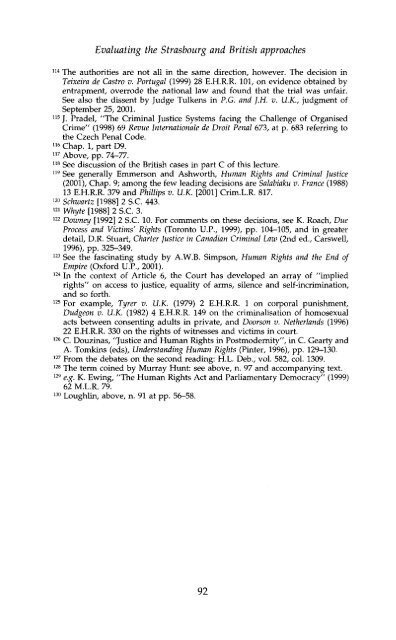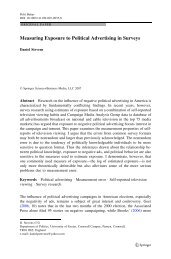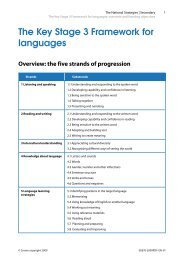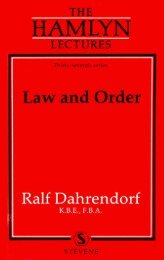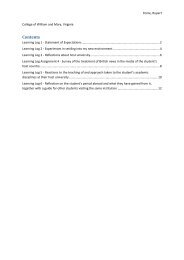Human Rights, Serious Crime and Criminal Procedure - College of ...
Human Rights, Serious Crime and Criminal Procedure - College of ...
Human Rights, Serious Crime and Criminal Procedure - College of ...
- No tags were found...
You also want an ePaper? Increase the reach of your titles
YUMPU automatically turns print PDFs into web optimized ePapers that Google loves.
Evaluating the Strasbourg <strong>and</strong> British approaches114 The authorities are not all in the same direction, however. The decision inTeixeira de Castro v. Portugal (1999) 28 E.H.R.R. 101, on evidence obtained byentrapment, overrode the national law <strong>and</strong> found that the trial was unfair.See also the dissent by Judge Tulkens in P.G. <strong>and</strong> J.H. v. U.K., judgment <strong>of</strong>September 25, 2001.us j p ra£ j e l, "The <strong>Criminal</strong> Justice Systems facing the Challenge <strong>of</strong> Organised<strong>Crime</strong>" (1998) 69 Revue Internationale de Droit Penal 673, at p. 683 referring tothe Czech Penal Code.116 Chap. 1, part D9.117 Above, pp. 74-77.118 See discussion <strong>of</strong> the British cases in part C <strong>of</strong> this lecture.119 See generally Emmerson <strong>and</strong> Ashworth, <strong>Human</strong> <strong>Rights</strong> <strong>and</strong> <strong>Criminal</strong> Justice(2001), Chap. 9; among the few leading decisions are Salabiaku v. France (1988)13 E.H.R.R. 379 <strong>and</strong> Phillips v. U.K. [2001] Crim.L.R. 817.120 Schwartz [1988] 2 S.C. 443.121 Whyte [1988] 2 S.C. 3.122 Downey [1992] 2 S.C. 10. For comments on these decisions, see K. Roach, DueProcess <strong>and</strong> Victims' <strong>Rights</strong> (Toronto U.P., 1999), pp. 104-105, <strong>and</strong> in greaterdetail, D.R. Stuart, Charter Justice in Canadian <strong>Criminal</strong> Law (2nd ed., Carswell,1996), pp. 325-349.123 See the fascinating study by A.W.B. Simpson, <strong>Human</strong> <strong>Rights</strong> <strong>and</strong> the End <strong>of</strong>Empire (Oxford U.P., 2001).124 In the context <strong>of</strong> Article 6, the Court has developed an array <strong>of</strong> "impliedrights" on access to justice, equality <strong>of</strong> arms, silence <strong>and</strong> self-incrimination,<strong>and</strong> so forth.125 For example, Tyrer v. U.K. (1979) 2 E.H.R.R. 1 on corporal punishment,Dudgeon v. U.K. (1982) 4 E.H.R.R. 149 on the criminalisation <strong>of</strong> homosexualacts between consenting adults in private, <strong>and</strong> Doorson v. Netherl<strong>and</strong>s (1996)22 E.H.R.R. 330 on the rights <strong>of</strong> witnesses <strong>and</strong> victims in court.126 C. Douzinas, "Justice <strong>and</strong> <strong>Human</strong> <strong>Rights</strong> in Postmodernity", in C. Gearty <strong>and</strong>A. Tomkins (eds), Underst<strong>and</strong>ing <strong>Human</strong> <strong>Rights</strong> (Pinter, 1996), pp. 129-130.127 From the debates on the second reading: H.L. Deb., vol. 582, col. 1309.128 The term coined by Murray Hunt: see above, n. 97 <strong>and</strong> accompanying text.129 e.g. K. Ewing, "The <strong>Human</strong> <strong>Rights</strong> Act <strong>and</strong> Parliamentary Democracy" (1999)62 M.L.R. 79.130 Loughlin, above, n. 91 at pp. 56-58.92


